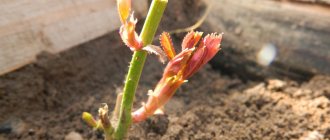The hybrid tea rose Black Prince is frost-resistant and resistant to typical diseases. It has a strong, wonderful aroma with notes of wine. The flowering is abundant and continuous throughout the season. All these qualities allow it to compete with newly bred varieties of black roses.
Thanks to its exquisite color and delightful aroma, the Black Prince rose has long won the love of gardeners around the world. With proper care it will bloom long and profusely. In this article we will look at how to properly care for a rose.
General characteristics of the Black Prince. Description of roses and application in landscape design
The plant at its peak can grow up to one and a half meters in height. The thorns on the stem are densely spaced, the foliage is dark green in color. From 1 to 4 inflorescences can appear on one bud. The bud has a dense core consisting of 40-50 petals. Newly ripened buds are almost black in color, but as they open, a burgundy tint appears. The varietal rose Black Prince has a number of positive qualities:
- the color of the bud corresponds to the name;
- tolerates severe frosts well;
- has a pronounced aroma;
- flowering lasts throughout the summer.
Rose Prince (The Prince)
Along with the positive aspects, there are also obvious disadvantages:
- in winter, in areas where the temperature drops below -15 degrees, it becomes necessary to cover the bushes;
- the variety is susceptible to diseases;
- Due to the fact that the stem and bud are connected by a thin peduncle, the inflorescences cannot be used in decorating the yard and landscape design.
Note! The Black Prince variety is not intended for landscape decoration. However, experts take risks and, despite the thin stalk of the plant, combine it with bush plants when planting.
Features of care
To obtain beautiful, rare-colored roses, you must strictly follow the rules of agricultural technology, and then that flower will repay you with gratitude.
Watering
When watering, it is important to know that lack and excess of moisture has a bad effect on the condition of the rose bush. It is necessary to determine the watering rate in each individual case. Definitely, until the soil under the bush has dried out, you should not water it, so as not to flood the roots, this will lead to their rotting.
On average, in dry summer weather, watering is done weekly, 2-3 buckets of water at room temperature per bush. In spring and summer, watering is done less frequently, and is stopped in the winter. You need to water the rose in the evening or morning, in a thin stream at the root, being careful not to get water on the leaves and flower petals. This can cause burns or attract fungal diseases. After each watering, the root circle must be loosened.
Top dressing
It is imperative to fertilize the Black Prince rose. This is the key to good and long flowering. Before flowering begins, during the period when buds appear, fertilize is applied, consisting of 15 g of ammonium nitrate, 25 g of superphosphate and 10 g of potassium salt per 10 liters of water.
After the end of the flowering period, the rose must be fertilized again. This time take 25-50 g of ammonium nitrate, 15 g of superphosphate and potassium salt per 10 liters of water.
Trimming
This procedure is necessary for the formation of a beautiful bush and for the long and lush flowering of the rose.
The first pruning is done in early spring before the buds swell. It can be of the following types:
- short - for 2 buds, for the formation of a beautiful crown and abundant flowering;
- medium – for 5 buds, usual for hybrid tea roses;
- long - for 10 buds, for trimming shoots that grow too quickly;
- sanitary – for removing broken and frostbitten branches after winter;
- rejuvenating - pruning right to the ground in order to renew shoots.
Mulching
After planting a rose and after each watering, it is necessary to loosen and mulch the root circle with straw, hay or fallen leaves in order to retain moisture in the soil and protect it from weeds and pests.
Weeds must be promptly and carefully removed so that they do not take away moisture and nutrients from the plant and do not contribute to the appearance of insect pests.
Reproduction
The simplest and most accessible method of propagation used for roses of this variety is cuttings.
The cutting technology is as follows:
- The shoots selected for taking cuttings must be semi-lignified, either at the stage of bud formation, or already faded.
- Cuttings are cut early in the morning from shoots that are located in the center of the bush.
- The length of a quality cutting should be 5-8 cm with 2-3 leaves.
- The lower cut is made at an angle directly below the bud, and the upper cut is made horizontally, 1 cm above the bud.
- Then the lower leaf and part of the upper leaf are removed.
- The cuttings are placed for a day with their lower part 1.5 cm in a solution of a root formation stimulator.
- The cuttings are planted in a special soil substrate with river sand and peat and covered with film for better rooting.
- After a month, the cuttings take root and can be transplanted into open ground.
Disease and pest control
The Black Prince rose is resistant to many common rose diseases, but black spot and powdery mildew can damage the rose if the planting site is not chosen correctly or if it is poorly cared for. Therefore, spraying with fungicides will not hurt as a preventative measure.
To protect against pests, it is necessary to promptly get rid of weeds, mulch the root circle, and carry out preventive spraying with insecticides.
Shelter for the winter
Despite the fact that the Black Prince rose is frost-resistant and can withstand -23 degrees below zero, it is recommended to cover it for the winter.
After the end of flowering and pruning, when stable frosts occur, all leaves are removed from the bush, the soil of the root circle is mulched, hilled up to 20 cm, covered with fallen leaves, covered with spruce branches and frames made of wooden boards are installed over the bushes, which are covered with a special film on top.
In early spring, they gradually begin to dismantle the shelter so that the overwintered rose bush gets used to the environment.
Rules for planting roses in open ground
Rose Prince (The Prince)
Rose Black Prince will bloom abundantly only with proper planting and choice of location. The plant can be propagated either by seeds or by cuttings. The simplest and most effective way is to plant shoots or seedlings. The optimal time for planting and propagation is considered to be the beginning of autumn. Although there are experts who believe that shoots planted before April are in no way inferior to their autumn “brothers”. Roses are heat-loving flowers, which is why when choosing a location you should give preference to fairly bright places without drafts. It is worth considering that the Black Prince does not tolerate direct sunlight.
Inflorescences
Before planting, you need to prepare the soil:
- thoroughly loosen the ground;
- treat for weeds;
- enrich with minerals and fertilize with humus if the soil is not fertile.
Important! Before planting the cuttings in the ground, it is necessary to pre-treat it. To do this, the prepared shoot must be immersed in a special stimulator, which promotes root growth. Exposure period: one day.
Reviews from gardeners about the Black Prince variety and its cultivation
Black Prince - the rose is very beautiful, the smell is excellent, like roses from childhood (not fruity, not candy) but roses. About two meters high. It grows in the shade, so it is always dark red in color. The flower lasts a long time, two to three weeks. Bush 1 m wide. Takes cuttings very well. It looks very beautiful in a bouquet.
6258541
https://www.rosebook.ru/roses/perpetual-hybrid/black-prince
A very beautiful rose. But not for my climate. In heat above 30ºC, the outer petals burn, shrink, and the flower dries out unopened. If you try to remove them, the flower crumbles in your hands. In the heat, the flowers droop and stick out like dry mummies. This variety needs an early, cool spring (this doesn’t happen often in our country) and a warm, dry autumn. Then the flowers are marvelous: a very deep velvety dark red color with black markings on the outer petals, up to 16 cm, fragrant, very beautifully shaped with a tall glass, opening into a double flower without a visible middle.
Zoya_z
Caring for black tea rose
Apricot Black Prince - description and history of fruit selection
The hybrid flower is considered capricious and quite demanding to care for. Be sure to follow the following recommendations regarding the care of new roses:
- proper organization of watering. It should not be frequent, but plentiful. After watering, you need to intensively loosen the soil. The frequency of watering the bushes should be once every 6 days;
- The beauty of the bush and the quality of the buds largely depend on the preparedness of the soil. The plant will curl upward if the soil is well fertilized with a solution of ammonium nitrate. Flowers love light, fluffy soil. If the land does not meet these requirements, then you can use a ready-made earth mixture for planting;
- trimming the stems is necessary to prevent the growth of wild shoots. The plant must be pruned in the spring;
- after the plant fades and the temperature drops below 5 degrees, care must be taken to prepare the bushes for wintering. The bush must be trimmed, all leaves removed, a frame body constructed and covering material placed on it.
Loosening the soil
Specifics of cultivation and agrotechnical recommendations
The variety is not capricious, but has average immunity and a tendency to be attacked by aphids, therefore it needs systematic treatment against pests and typical diseases. It has good frost resistance, but in regions with harsh climates and winter temperatures below −25… −28 ℃ it requires shelter. Among the disadvantages of the variety, it is worth noting the weak peduncle, which, during prolonged heavy rains, simply cannot withstand the weight of the already large flowers and can break off.
For planting, illuminated sunny areas with partial shade during the day should be allocated. The selected location should be protected from hot and dry or icy gusty winds.
In the bright sun, “Black Prince” loses its unusual color and becomes simply burgundy or crimson. To preserve the “charred” effect, it is better to plant the bush in partial shade.
Seedlings take root well on different types of soil: both moderately and slightly acidic (pH from 5.6 to 6.5), and neutral and slightly alkaline (6.6-7.8). The more acidic the soil, the darker and more saturated the color of the petals. Fertile, structural, permeable soils are suitable for cultivating the variety. The best option is chernozem loam. Areas with high groundwater levels should be avoided.
Planting in the ground is carried out in the spring, when the soil has warmed up sufficiently, or in early autumn (preliminary autumn soil preparation includes deep digging with the application of mineral fertilizers). The dimensions of the planting hole should be approximately 35x35 cm. A drainage layer is laid on the bottom and 3-3.5 kg of compost or rotted manure is added. The root collar is buried 5-6 cm. The seedlings are watered abundantly (10-15 l), then the soil is mulched.
For the “Black Prince”, replanting is strongly not recommended - after it the bush becomes seriously ill and takes a long time to recover.
Inexpressive faded green foliage with a reddish tint is considered one of the disadvantages of “Prince”, which reduces its decorative value. The variety is mainly grown for cutting or aroma in the garden.
Subsequent care of the bush consists of regular loosening, watering, fertilizing and pruning (in the spring for sanitary and formative purposes, in the fall before covering). The variety loves abundant and regular watering: the optimal regime in hot weather is 1 bucket of settled warm water for each bush every 5-6 days. Excessive humidity causes flowers to lose their bright color.
The variety is ideal for cutting, has a wonderful aroma and looks great in a flower bed among white, cream, blue and lilac flowers, which emphasize the spectacular coloring of the “Black Prince”. Dark flowers look great against the overall green background of a well-groomed lawn.
Bushes can be grown in container culture - large pots and flowerpots used to decorate verandas, terraces and patios
Bloom of the Black Prince
The buds of hybrid tea roses of the climbing group begin to open at the beginning of summer and continue flowering until the onset of the first cold weather. However, many are faced with the problem of a lack of flowering in climbing groups of roses. This may be due to the following reasons:
- a young bush of the first year may not bloom;
- wrong landing site;
- poor pruning or care;
- presence of diseases or root rot;
Important! During flowering, it is necessary to prune the bush, cutting off faded buds at an angle of 45 degrees.
Flower propagation
Reproduction methods are given in the table.
| Way | When is it produced? | Description |
| Semi-lignified green cuttings | summer |
|
| Lignified cuttings | spring | |
| Dividing the bush | before buds open |
|
| By layering | early spring | Cuttings at least 1.5 years old are separated from the mother bush and planted as an independent plant. |
Diseases, pests and ways to combat them
The greatest damage to the plant can be caused by:
- Powdery mildew. All affected parts are cut out and burned, and the rose is treated with an ash solution infused for 5 days (1 glass per 10 liters of water).
- Black spot. Spring treatment with Fitosporin in 2 stages will help: first with a solution of 7 ml per 1 liter of water, and after a week - 3.5 ml per 1 liter of water.
- Rust. To prevent this, already affected bushes are sprayed with a solution of Bordeaux mixture in 2-3 doses with an interval of 7-10 days.
- Aphid. Sprayed with Spark, Bison, Commander.
- Leaf roller. The drug Molniya helps.
- Spider mite. Spray with Iskra-M solution in two approaches with an interval of 10-12 days.
Growing a Prince in the garden is an activity for true connoisseurs who are passionate about obtaining rare and unusually beautiful flowers. The rich lilac-violet hue and fabulous aroma are the most famous characteristics of this English rose.
https://7ogorod.ru/cvety/roza-cernyj-princ.htmlhttps://dacha.help/cvety/roza-chernyy-princhttps://greensotka.ru/tsvetushchie/prints-roza.html
Top dressing
If you notice that the buds of the Black Prince rose (photos are posted in the article) have begun to wither, they need to be removed. With what it can be connected? Most likely due to lack of nutrients. Rose Black Prince requires mandatory and regular feeding due to the fact that the plant spends too much energy on the formation of luxurious flowers.
It is advisable to apply organic fertilizers in late autumn, and mineral fertilizers in spring. The next feeding is carried out after the rose has bloomed, but no later than mid-July. At this time, nutrient formulations containing large amounts of potassium are suitable for plants of this variety. This will help increase the bush's resistance to low temperatures.
Flowering and dormant period
Many gardeners do not even suspect that Zamioculcas Black can bloom. This happens once every few years, but only when ideal conditions are created. The peduncle grows from a tuber; its height can be from 3 to 20 cm.
The inflorescence is a large ear surrounded by a blanket of petals
Reasons preventing flowering:
- non-compliance with temperature conditions, excessive watering or lack/excess of light;
- lack of minerals;
- unsuitable pot size;
- diseases, insect attacks.
The dormant period begins at the beginning of October. From this time, you should stop feeding, reduce watering and move the pot with the plant to a cooler place.
Varieties of hybrid roses
Today, owners who want to purchase a hybrid rose are simply overwhelmed by the many varieties of varieties.
As we have already said, each variety has its own characteristics, which you should pay attention to.
- Alexander. This variety has medium-sized flowers, the petals of which are bright red in color. Often the flowers are double. The bushes themselves are lush and tall. The advantage of this variety is its long flowering period. If we talk about the areas in which this variety can be used, we can note the excellent resistance of the flower to low temperatures, as well as to various types of diseases that usually affect roses.
- Hybrid tea rose Aqua. A medium-sized plant, the height of which can reach 80 cm. The flowers themselves can have a diameter of up to 12 cm. The interesting thing is that, regardless of the period, the bush will always remain in the same color. The Aqua rose blooms at the end of July and continues until late autumn.
- American Pride. These are dense bushes that have lush flowers with velvety petals. The color is often dark red. At the same time, this variety of roses does not emit a special aroma. The height of the bushes often reaches 80 cm, and they are also highly dense. The leaves of this plant are large and hard.
- Hybrid tea rose Kerio. This is probably the most unusual variety of hybrid roses, and all thanks to the bright yellow color of the roses. At the same time, the flowers themselves can have a huge number of different shades, which makes them truly unusual. In addition, the flowers are large in size - up to 13 cm in diameter, and during the flowering period they may change their shade slightly, but in any case it will be light. The leaves of the bush are quite large and shiny. The height of the bush can reach a height of up to 1.2 m.
- Hybrid tea rose Consul. This is a classic variety of roses, which is distinguished by velvety flowers, as well as an incredibly strong aroma. The flowers can reach a diameter of 10 cm, the leaves of the bush are small and dark green.
- Die Welt. It is also quite an unusual variety for roses, as the flower petals can be yellow or orange. The bush can reach a height of 1.2 m, it is dense, but relatively compact. The leaves of the bush are large and shiny. Unlike other varieties, Die Welt roses bloom throughout the warm period, which is good news.
- Hybrid tea rose Versilia. The petals of this variety are cream-colored, sometimes peach-colored. The buds can have a diameter of up to 12 cm. Some experts call their shape “goblet-shaped”. Flowers appear as many as 2 times during the warm season. The bushes reach 1.2 m in height and also have thick and shiny leaves.
- Hybrid tea rose Gloria Day. This variety of roses is often chosen because it is resistant to low temperatures. Rose Gloria has double flowers that reach 15 cm in diameter. The color of the petals can be pink, golden or yellow-pink. The bush has large thick glossy leaves. Flowering occurs almost before the onset of severe frosts.
- Hybrid tea rose Versilia. This variety is distinguished by creamy yellow flowers. The diameter of the buds reaches 12 cm, while their shape is quite unusual (goblet-shaped or pointed). The flowers appear as many as 2 times a season and have a pleasant aroma. The leaves of the bush are large and shiny.
- Hybrid tea rose Black Baccarat. This flower is distinguished by the scarlet color of its petals, the diameter of which can reach 10 cm. The flowers cover almost the entire bush, which makes it incredibly beautiful. Flowering continues throughout the warm period. Again, this variety is resistant to both low temperatures and various diseases.
These are not all varieties that are popular among summer residents and gardeners. There are several more options for hybrid roses, which also have their own distinctive characteristics. Despite this, you can easily make the right choice among the list of varieties presented above, since there you can find flowers with all the necessary parameters (appearance, frost resistance and flowering period).











